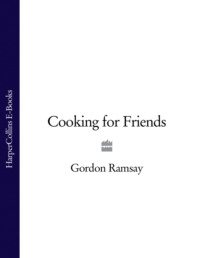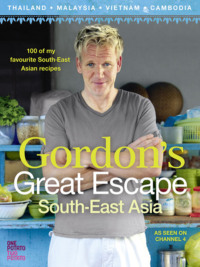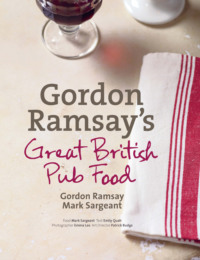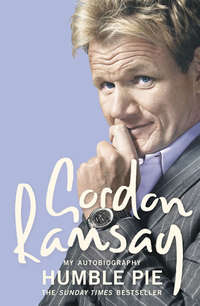
Полная версия
Gordon Ramsay’s Playing with Fire
Claridge’s restaurant had been on the ground floor on the west side of the hotel for 100 years and had probably never turned a profit. It was a mausoleum – a huge, high-ceilinged cathedral where tail-coated waiters had pranced between the tables, dispensing arrogance and superciliousness while serving plates of grown-up school dinners. The task facing any designer would be daunting. It was easy to throw out the aspidistras and Victorian bric-à-brac, but all that was left was an echoing cave large enough to hangar a jumbo jet.
One winter’s day, we found ourselves in Tribeca about to meet the man who was going to change all that. His cold store had been transformed into an amazing five floors of sample rooms, drawing desks and Apple Macs. He was a tall, nasal Frenchman with a confidence and arrogance that I liked. Moreover, he was someone who listened to us when we started on the long list of considerations that he would have to take on board. He presented a three-dimensional concept of what he had in mind. Fucking breathtaking, as we sat and watched. This was the guy who spruced up the Statue of Liberty on its 200th birthday, and now he was about to design my new restaurant.
You may remember that, earlier on, I thought that the Claridge’s challenge was about to launch us into a different league and, in doing so, it would introduce me to a whole new world of international travel and an involvement with people who think in global terms. You know that I am already beginning to understand that this will become the template for the years to come, and I am shitting myself with excitement.
The deal to take this over was as simple as ABC. The owners were to pay all the big bills. The megabucks that were needed to make it happen came from them. All I had to do was find the money to supply the china, the silver, glassware, the ‘tabletops’, the staff uniforms, the kitchen equipment and a little working capital. I say ‘a little working capital’ because, of course, when the restaurant opened, money started to come in on the first night, even before the last table was crumbed down. That meant we had thirty days before we had to pay the staff and sixty days of income before having to pay a supplier. Chris, who had come from a thirty-year career in printing, reminded me that he had to wait between sixty and 120 days for his money in his previous life. The only thing that spoilt this positive cash flow arrangement was having to pay three months’ rent in advance, provide a minimum of £100,000 in authorized and paid-up capital, and arrange a letter of credit from the bank to cover a quarter’s rent in case of default. In addition, we paid 11 per cent of our net takings to Blackstone by way of rent. As I said, easy as ABC.
The negotiations over the drafting of the lease and the operating agreement went on forever. Chris spent hours in meetings with marked-up drafts going backwards and forwards. What we didn’t realize then was that the format was to become a way of life for the two parties, and was to be used for a further twelve restaurants at the time of writing this. And that’s simply because we got it right at the beginning.
The restaurant build seemed to take forever. It did, however, give us time to recruit the right staff, train them and make sure that everything was in place, ready for the big opening. It was time to acquaint ourselves with systems and procedures, which, in the coming two years, grew into Gordon Ramsay Holdings and set the stage for three new openings a year for the following five years.
The opening night was a glitzy affair – a real ball for all. The restaurant was cleared of tables and chairs so that over 500 guests could enter through the magnificent foyer of Claridge’s to see the fabulous transformation of the mausoleum. Outside along the kerb were half a dozen nineteenth- century hackney carriages, each with a pair of horses with their noses in their feedbags – right back to when Claridge’s first threw its doors open to the public. The press boys were everywhere, and even then, on that very first night, before the till had even rung up once, I knew that we had just broken through rock and found a vein of gold. John Ceriale, a shy man when it comes to the public, was there to see the launch of his baby with a grin the size of the Brooklyn Bridge.
That is not to say that Gordon Ramsay at Claridge’s proceeded without a hitch. In the first year, we bottom-lined at £600,000. The second year was much the same. But in the third, we closed the year off at £1.65 million and then went on to reach close to £2 million in each successive year, and that must tell a tale.
The first year was hard. We were soon receiving, on average, sixteen letters of complaint a week, and something had to be done about it. The weekly operations meeting was born, which was no more than a meeting of the restaurant director, his managers, the head chef and his lieutenants, the head receptionist, the HQ heads of department from HR, training and private dining, and either Chris or myself to chair the meeting. They were often merciless meetings in our search for perfection. I recall one week when there were eighteen people all sitting in a large circle without a table to hide behind, and one of the receptionists, a fat, self- contented moose, smirked after admitting that she had lashed up on a booking. The smirk drained away as it was pointed out that, as she had risked jeopardizing the GR name with her recklessness, she could now leave the room, leave the company, and never be heard of again. And that is exactly what happened. Amazing, after that, how we had everyone’s undivided attention.
So, what happened during the first two years that added a million pounds to the bottom line? Why did that not happen from the beginning? Surely there was a simple enough formula here of booking guests in from an apparently endless list of reservations requests, offering the same menu each day and washing the dirty plates at the end of each service. Most restaurants would have given their eye teeth to make £600,000 a year, but we knew that there was an opportunity to fine-tune every area of the operation, leading to bigger bucks and true longevity for the restaurant.
The single most effective step was to introduce profit and loss numbers to the kitchen management. Chefs are not normally numbers people, but I saw how they sat up when Chris alluded to the information that the office could pick up from the kitchen’s activities just from the food margins, the primary indicator of how much was spent on ingredients, compared to the amount of food sales. If the chef carried on buying Welsh lamb when the prices went up without increasing the menu price or switching to Pyrenean lamb, his monthly food margin would drop a couple of points, and the office knew there was a fuck-up somewhere. The menu stayed more or less the same and, therefore, the food margins did not falter.
As the kitchens began to understand the importance of buying intelligently, turning stock and charging in accordance with market costs, a bonus system was introduced in accordance with performance. As such, it represented financial rewards for doing the job right. Commission or bonuses are nearly always associated with sales or deal making, and it just seemed right that safeguarding aspects of the bottom line also deserved reward and motivation to keep going along that track. This had to be carefully watched, as the last thing I wanted was overkill when margins rose at the expense of quality. That was not the idea. It’s just that, when I think back to Royal Hospital Road, it was always our boast that we never bought on price, just quality and timely delivery.
The other essential indicator was salary costs as a percentage of sales. There had to be sufficient staffing, but not over-staffing. Also added into the formula had to be the training and retention of staff. When commis enlisted and then left in less than six months, we came up with a bonus system, whereby those staying for a year earned a one-off payment at the end of the term. This immediately had anyone thinking twice before throwing in the towel.
The art of upselling is a sensitive but necessary subject. There is nothing more irritating than when a table is approached half a dozen times and asked if they want water. Once is fine, and the question has to be asked. After that, it is vital that an indicator is left on the table so that any further approach is avoided. Either remove the water glasses if it was ‘No,’ or place a bottle coaster on the table to indicate that a bottle is already on the way. So simple.
Successful and intelligent upselling is bringing to the guests’ attention something that they want, but just hadn’t thought about. Sit a party down at the table and ask them what they may like to drink, and there will be total confusion. Particularly if the guests don’t know each other. Suggest the champagne trolley, and you’re home and dry. It cuts across the whole problem for a guest who doesn’t want to be the first to choose. And, in the meantime, you kick off with six glasses of pink champagne on the bill at £9.50 a glass, with six happy guests who are beginning to realize that they are going to enjoy themselves.
Statistics on the Gordon Ramsay at Claridge’s scale did my head in at the beginning. At Claridge’s, we agreed to put £1 on every bill in the months of November and December for a London charity called StreetSmart. The proceeds were to go to London’s down-and-outs, and we, in fact, decided to extend this to six of the restaurants. So, how much did £1 a table produce in those two months for six little restaurants? Something in the region of £23,000. That means that we served 23,000 tables – not guests – in sixty-one days. Extend this to the number of feet belonging to all the guests (allowing an average of two feet per guest) that make up these tables, and you begin to understand why we need a twenty-four-hour maintenance team, why we need to replace the fucking carpets every three years, and why, unless you do this, the place will wilt like a lettuce leaf at Ascot.
What do guests look for more than anything when entering a restaurant? What they want is attention. They want to see a smile, an acknowledgement, a welcome the moment they enter, and the average restaurant is fucking crap at this simple courtesy. Either you are completely ignored and staff at the reception desk carry on talking among themselves, or someone challenges you with ‘Name?’ And on giving your name, they repeat it like a fucking automaton, without so much as a ‘Mr’ or ‘Mrs’. Their attention then flicks down the reservations list, and they proceed to highlight the name in Day-Glo green or rub it out like a gleeful schoolgirl, fresh from a shoplifting spree at Office World.
People in a restaurant see it as their chance for recognition. Give them a warm, welcoming smile. Get their name right with the appropriate title, and make it sound like you are really pleased to see them. They are already flushed pink that they are recognized and have your undivided attention. A good restaurant manager understands this, and ensures that his staff are drilled to follow these simple rules. For Christ’s sake, the guests’ satisfaction is what your job is all about. Get it wrong and you will hear no more because there won’t be any guests left.
Once past the desk, the guest is now looking out for two things: which table he’s going to get and whether any of the other guests are looking and thinking, ‘a regular’ or ‘Who is this git who’s getting the special stroking?’ All part of the service, and still not a menu in sight.
So, in the early days of Gordon Ramsay at Claridge’s, we decided to do something about the smile factor. I guess it stemmed from a remark that Chris made when he was asked what qualifications he had to run restaurants. He just looked up and said, ‘I eat in them.’ You see, what was going around in his maze of a brain was that chefs and waiters only see what they do from their own positions. They come through college, tiny kitchens and bistros, and never get to see the wider picture. I think it’s called one-dimensional. So what I decided to do was invite our own staff to experience their own restaurant. Get done up, bring their nearest and dearest, and have a good time. They’ll soon get pissed off if they are kept waiting for the main course or they have to pour their own wine or they have to try and understand what Zolga, the waitress from Latvia, is trying to say about the menu. It’s an advanced education so that they actually know what it feels like when things go wrong. Why don’t air crews get nervous when the wings on their planes flap hysterically in turbulence halfway across the Atlantic? They stay calm because they have been shown that the plane is built to survive, even when concrete blocks are dropped on it.
And that’s what knowledge and understanding in Gordon Ramsay at Claridge’s brought me. What we achieved as a team became an amazing success story. Ultimately, it depended on the little things like the smile people get when they come into our restaurants and the understanding of our guests’ expectations gained first-hand by our staff. As ever, it is the detail that counts.
CHAPTER SIX
FOREIGN FIELDS
Control from afar will bring its own problems, and shouting from a thousand miles away becomes but a whisper.
BY THE END of 2000, my two London restaurants were running well. Mark Askew was looking after Royal Hospital Road in his usual brilliant and protective way, and Marcus Wareing was steering Pétrus into its second year of trading. It was a time for me to get bored or to look for something else – or somewhere else. I felt that somewhere there was a greater pulse to life, but I couldn’t quite see how to grasp it.
What I was about to learn were the basic, underlying secrets of how to expand globally, with restaurants that were thousands of miles away. Same standards of cuisine, same standards of service, but with lines the length of which we had to extend control.
Then, just before Christmas that year, we had a call from Hilton asking if we might be interested in opening a restaurant in their new hotel in Dubai. It sounded a bit exotic, and both Chris and I were immediately all ears. This could be our first venture outside the UK, and, at the time, there were bucketfuls of hype about duty-free shopping malls and the unrelenting, bronzing sunshine of Dubai.
After a blitz of initial e-mails, we both agreed to go to Dubai straight after Christmas.
I have to say that, in those days, I never really got the hang of what Dubai was all about. Maybe you had to see it as a holiday resort where you just went and broiled yourself in the sun, but there seemed so little to do. Still, all we were doing was checking it out as a possible site to spread our wings.
We arrived on a Thursday in January 2001. This, actually, was treated in the Muslim world as a Saturday, and Friday became Sunday. Different culture, different calendar. I could cope with that, so what’s next? Well, no stand-alone restaurants. All restaurants had to be in a hotel. Hmmm. OK.
We were picked up at the airport and taken to the Hilton Dubai Jumeirah, immediately learning Lesson One, that there were two lived-in parts of Dubai: the city itself and the resort area, with forty-five minutes of motorway between them. Our itinerary was full-on, even if Hilton hadn’t quite got the hang of how to spell my name or, for that matter, the word ‘itinery’. It was filled with presentations of the project, visits to half a dozen restaurants and a dazzling venture into the desert, riding a four-wheel wagon along the ridges of the dunes in the early evening and then stopping to watch the breathtaking sunset.
We were taken for lunch in a submarine to the seafood restaurant within the Burj Al Arab and then shown around this towering monument to the future of Dubai. The submarine, of course, didn’t move, and when I went into the restaurant, with its wrap-around fish tank, I began to realize that I had entered a Disneyland for crustaceans. I can’t even remember what the food tasted like, and I guess that most people left with the same experience.
The hotel was just a building site in the city next to the Dubai Creek. It was also the first building I had ever been in while it was being built. It is so difficult to visualize a bar area or the entrance to your restaurant when all you see in front of you is raw concrete and piles of sand, tiles and hard hats. But I couldn’t help being impressed. It was to become a beautiful steel and glass boutique hotel, probably not in the best position for the Dubai tourist, but graceful and upmarket.
But when we went on an early morning visit to the fish market it was a different story – and a frightening experience for the prospect of doing business there. The heat was fucking incessant, and there was all this fish lying around in the least hygienic environment imaginable. Great slabs of tuna weighing 200 pounds were left for an hour on the tarmac of the access road while someone went off to get the truck. The place was a fucking shambles, and I was glad to move out of the smelly, dirty sales halls. The thought of coming down to market in the early morning to buy the day’s fish supplies for the hotel didn’t give me a rush of confidence. Here, for sure, was a clash of the old Arab culture and today’s new hotel culture, with all its Western expectations.
Nor was the welcome from the owners exactly overwhelming. This was going to be a three-way deal between them, Hilton as the operators, and us for the food and beverage consultancy. So, I guess, in the owners’ minds, we were just a Western name that had to be imported. They would have little control over us, so we were an irritating necessity that had to be tolerated.
It struck me then, as it has many times since, that hotel operators around the developing world have to adapt themselves to a million different cultures. I have met one or two senior hotel people who do nothing but act as diplomats, easing the relationships between operators and owners. I always think of it as a hard way to earn money.
After all that, the trip was a success. We left Dubai agreeing to move forward, and the deal was relatively simple. We would license the name of Gordon Ramsay to Hilton for its use in anything to do with promoting food and drinks in the hotel. We would also supply ten senior staff members and the menus, and be consultants about food and drink. All that was left was for Hilton to come over to London, with the owners’ representatives, so that we could show them we were the right choice.
But there was an immediate problem. We could hardly sail into our shoebox office in the Fulham Road with our guests and announce that this was our headquarters. Not much commercial cred there. So, Chris’s sitting room in Mayfair, with its enormous oak table, had to become our central office. Miraculously, it worked. By the time they had been to the restaurants and listened to Chris’s spiel, we were in, and they were happy to start the legal process. Looking back now, it was probably the last time we had to puff out our cheeks to make ourselves look bigger than we were.
In the following months, we did everything necessary to get the the hotel ready for its opening. We had already decided on Angela Hartnett to lead the team in Dubai. She would leave our employment and join Hilton for a two-year tour. This was an inspired choice because Angela was so much more than just a chef. She could organize and motivate people and still remain the beautiful survivor of the Aubergine days. No one could resist her charming manner, and I always knew that our name in Dubai would be safe.
Towards the autumn, the hotel began to open. I say ‘began’ because that’s how it was. First, the foyer and a few floors were open to the public. Then the food and beverage operation kicked in, and, gradually, the show hit the road. That is, until the fateful date of 11 September 2001. This was to guarantee an almost empty hotel for weeks to come. Suddenly, nobody wanted to go near the Middle East.
It was a bit like John West tinned salmon and Perrier water. They both collided with commercial reality, but memories faded a little bit with each dawn. It just needed the rawness of what happened to blur a little, and then things began to return to how they were – or in our case, how they were meant to be.
The one thing that we, as restaurateurs, hadn’t yet experienced was the difficulty of dealing with problems so far away. If something flares up in Mayfair or St James’s, we can be there in ten minutes. Not so when your restaurant is thousands of miles away, in a different time zone and, for that matter, on different days of the week. What’s more, we were already dealing with the beginnings of Gordon Ramsay at Claridge’s and the end of our first Scottish adventure. Somehow we had to hold it together, and deal with Dubai at a distance.
The early problems were about hiring and keeping staff when they were far more used to our salary scales than the budget-driven rates of Hilton employees. That was when we started to do something really stupid. To keep our people there to protect our name and promote all things Gordon Ramsay, we started to pay them a supplement from London. Apart from our signing-on fee, all we got was a flat percentage of the monthly food and beverage turnover. After 9/11, this revenue stream was so thin that our staff supplements were gobbling up the whole lot.
Worse, our main restaurant – which we called Verre – was short of most of the elements that go into a restaurant for fine dining. Chris went over a number of times and would leave pages of notes on how to turn this around. Most of all, he begged for a carpet. It was perfectly clear that the wooden floor, glass wall and absence of any drapes or soft furnishings needed a rethink. Quite apart from anything else, the quietest conversation would echo around the room. A carpet would have been a good start, but a year passed … and still no carpet.
It was so difficult for Hilton to persuade the owners to respond that I began to think that this wasn’t about running a decent restaurant or hotel, but some private battle of wills. Or maybe the owners just decided to do it in their own time. For some bizarre reason, we were never allowed to contact the owners directly. This was their rule, not Hilton’s, and it was the one and only agreement we ever had where we never got to speak to our partners.
I’ll say one thing for Hilton. They were always tied to their budgets and hotel culture, but they were sometimes capable of thinking outside the box. Chris explained that, if they insisted on giving tiny rooms to the Gordon Ramsay inmates and salaries to match, there would soon be no staff worth having. They agreed to tear up the agreement – or, at least, rewrite the relevant clauses. At last, we were able to drop our salary supplements. Even a new carpet threatened to happen, and solutions to all the changes that we had whinged about. Finally, and it was an enormous fucking relief, Gordon Ramsay at the Hilton Dubai Creek began to take off. Both parties had acted like grown-ups and, at last, we were marching on together.
We have never made much money in Dubai. There have been regular revenues fed over to us and paid in what must be the world’s weakest currency, the US dollar. But the one message that came loud and clear was that a lot of the guests who came to our London restaurants also visited Verre in Dubai. They go there, I think, because they feel that they can rely on the quality and the standard. It repeatedly won Time Out Dubai’s Restaurant of the Year, and was clearly rated as the pinnacle of cuisine in the city.
Angela came through her two years like a shining star. Her rapport and loyalty with the staff were legendary, and she was able to keep her head in a crisis. Sometimes, the crises were extreme. After one successful Christmas, she organized an evening on a barge in the creek with a buffet and dance for all the staff. As she sat next to her senior sous-chef at the stern of the rusting tub, the handrail gave way, and both plunged into the black waters. By the time they were fished out, the sous-chef was dead. This was like the loss of a family member, and yet, the following morning, Angela was back in her kitchen and there for her staff when they needed her.










